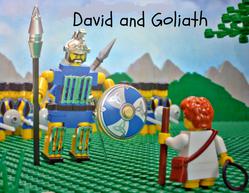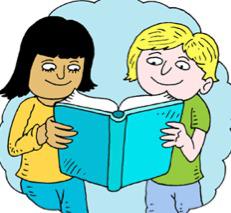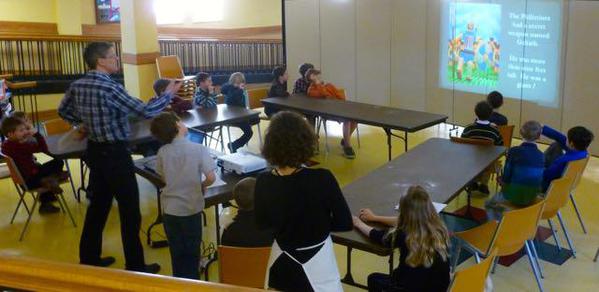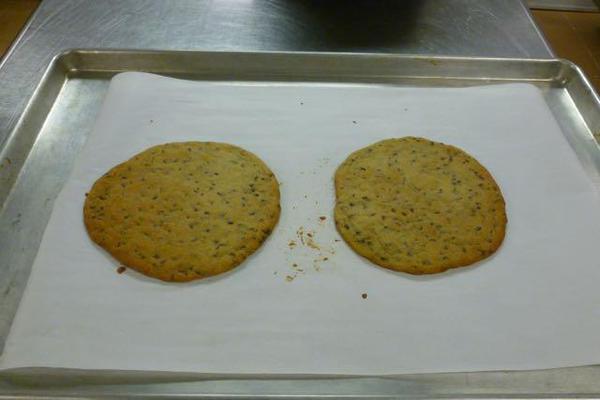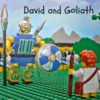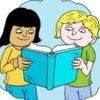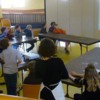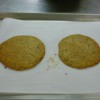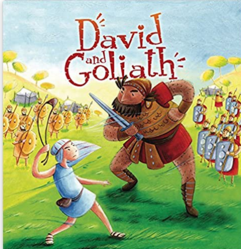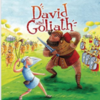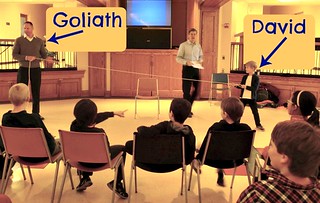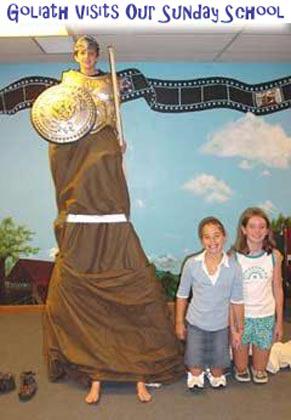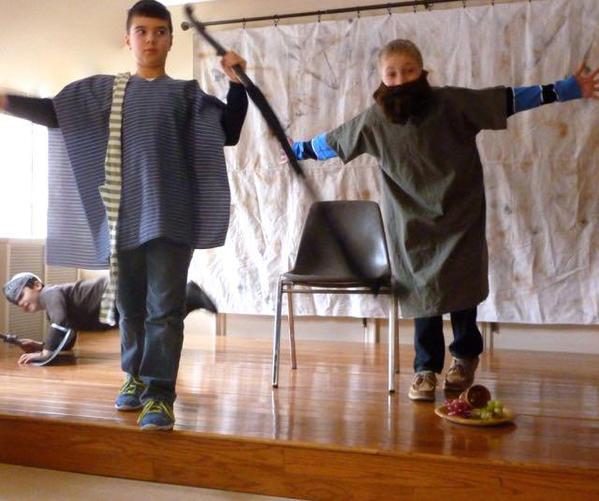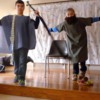Here is a complete set of lessons for…
David and Goliath
Summary of all workshops in this Rotation:
- Art: make two stick puppets- one to represent Goliath (a giant in their lives) and the other to represent what our shield is. (Note: written for 1st - 3rd grades, easily adaptable for older kids.)
- Cooking: Make a giant cookie and discuss giants in their lives.
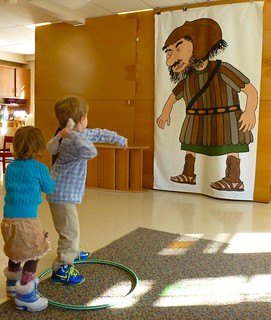
- Games: Answer game questions to throw a "sock-rocket" at a giant. Focus is on learning story details.
- Puppets: Use object theater (i.e., kitchen utensils as story characters) to enact the story. (Note: written for 4th-6th grades)
- Video: View portions of the video, The Beginners Bible Series: The Story of David and Goliath.
- Drama: Two lessons are included --
- #1: Enact the story of the Israelites facing Goliath including, of course, a giant! (Note: written for 4th-6th grades)
- #2: Read through the script and perform the skit “The Day the Bully Went Down” from 30 New Testament Quick Skits for Kids. (Note: written for 2nd-5th grades; a copy of this script is not included for copyright reasons.)
Scripture Reference: 1 Samuel 17:1-49
Key Verse: "Have I not commanded you? Be strong and courageous. Do not be terrified; do not be discouraged, for the Lord your God will be with you wherever you go.” Joshua 1:9 (NIV)
Rotation Objectives — After completing this Rotation, participants will be able to:
Name that the story is found in the Old Testament.
(2nd grade and up) Locate the story in the Bible. Identify that this story is found in the collection of Bible books called “History.”
Retell the story of David and Goliath.
Express the unlikelihood of an outcome of David battling the giant Goliath with just small stones; his greatest tool was his faith in God.
Explore how a person develops trust/faith in God.
Identify potential “giants” in their life and recognize that God can be trusted to help them face those giants.
Story Background
David was a shepherd, songwriter, soldier, great king, and ancestor of Jesus. He easily qualifies as a hero of the Old Testament (in spite of also having a number of negative qualities). Our Rotation will focus on an encounter David has with a giant named Goliath, an event that takes place when David is a youth, before he becomes king.
The story of David and Goliath is perhaps the most well known story in the Bible. It is easy to understand the appeal of this narrative for kids; there is suspense, excitement, and a great outcome: a small guy triumphs over a bully. But what life application can our kids take from this Bible story? The intention is not to teach our children to throw rocks at bullies! While kids don’t often find themselves literally on a battlefield, we all do face “giants” – both externally and internally. This is a story about using faith in God to fell those giants.
Who was David?
Our kids learned of David last September, in the story of David’s anointing (1 Samuel 16:1-13). The youngest son of Jesse, David lived with his family in Bethlehem. At that time, Saul was king of Israel. Saul had started off as a good king, but he had become rebellious and no longer obeyed God. God instructed the prophet Samuel to anoint one of Jesse’s sons as a replacement king.
Samuel followed God’s call and traveled to Bethlehem to seek the new leader. One by one, Jesse’s eldest seven sons were introduced to him, but none of them was the one chosen by God. Finally David was called from the fields where he was tending the family’s sheep. “Then the Lord said, ‘Rise and anoint him; he is the one’” (1 Sam. 16:12c).
Anointed as king
The process of anointing someone – pouring oil on their head – was used to set someone apart for service to God. As Samuel anointed David’s head with oil, “from that day on the Spirit of the Lord came upon David in power” (1 Sam. 16:13b). David was anointed as king, but this anointing happened in secret. Though Saul knew he was being replaced, (1 Samuel 15) he was still legally the king. It wasn’t until later that he would learn that David was his replacement – but that’s another story!
Still a shepherd
David had plenty of time to mull over his anointing experience. God’s plan for the future of his people – the kingdom of Israel – depended on David. Imagine the strength David would gain from knowing this! God had his back!
As he awaited God’s plan to be put into action, David kept busy tending sheep. We also know he played the harp. Perhaps he experienced closeness to God through his music. As we’ll learn later in our Bible story, being a shepherd gained David valuable skills. 1 Samuel 17:34-35, David describes his bravery in protecting his sheep:
When a lion or a bear came and carried off a sheep from the flock, I went after it, struck it and rescued the sheep from its mouth. When it turned on me, I seized it by its hair, struck it and killed it.
Meanwhile, on the battlefield
The Israelites found themselves threatened by their enemies, the Philistines. Jesse’s three oldest sons were sent to join King Saul’s army against the Philistines. “So the Philistines and the Israelites faced each other on opposite hills, with the valley between them” (1 Samuel 17:3). Right from the start, neither side wanted to start a battle in such terrain. Who would risk an attack across open ground and up the opposing slope? Given the situation, it was common for an army to avoid the high cost of battle by pitting their champion against the champion of their enemy. Thus, Goliath, a Philistine giant over nine feet tall, sets forth his challenge:
Goliath stood and shouted to the ranks of Israel, “Why do you come out and line up for battle? Am I not a Philistine, and are you not the servants of Saul? Choose a man and have him come down to me. If he is able to fight and kill me, we will become your subjects; but if I overcome him and kill him, you will become our subjects and serve us.” Then the Philistine said, “This day I defy the ranks of Israel! Give me a man and let us fight each other” (1 Samuel 17:8-10).
Check out the description of Goliath’s protective coverings in 1 Samuel 17:5-7. His armor weighed 125 pounds! For forty days, twice a day, Goliath would stride out to challenge the Israelites, verbally taunting them. Imagine him shouting put-downs against “the army of the living God” (1 Samuel 17:26c).
Why won’t anyone fight Goliath?
Saul and the Israelite army were frozen with fear. This fear at first seems reasonable – Goliath sounds terrifying! But a little knowledge of history can make this fear also seem puzzling. The Old Testament history books of Joshua and Judges are full of stories of successful battles against insurmountable odds, as long as the Israelites obeyed and trusted God. Shouldn’t the Israelites be asking, “Only one giant?” (Deffinbaugh). It is in Joshua (1:9) that we find the apt words of our key Bible verse (which the Israelites needed to remember):
Have I not commanded you? Be strong and courageous. Do not be terrified; do not be discouraged, for the Lord your God will be with you wherever you go.
It seems that Goliath is intimidating due to his size, but also because the kingdom of Israel lacks faith in God.
David arrives on the scene
Recall that David’s three older brothers are on the scene of this “battle.” Their father, Jesse asked David to bring his brothers some food. As David arrived in camp he heard Goliath’s ranting. David understood that when Goliath insulted God’s people, he was also insulting God. To not respond was shameful. David knew what to do. He told Saul, “Let no one lose heart on account of this Philistine; your servant will go and fight him” (1 Samuel 17:32).
Preparing for battle
Because of his young age and small size, Saul tried to dissuade David from fighting, but David is convinced that he should fight Goliath. “The Lord who delivered me from the paw of the lion and the paw of the bear will deliver me from the hand of this Philistine” (1 Samuel 17:37a).
Saul then gave David his own armor, including a bronze helmet and his sword, but David was not accustomed to the weight. He told Saul, “I cannot go in these, because I am not used to them” (1 Samuel 17:39b). So it was that David went off to battle with only his shepherd’s staff, his slingshot and five smooth stones plucked from a stream.
Why did David refuse Saul’s armor? He had faith! He knew he could defeat Goliath by trusting in God and relying on God's power.
When Goliath saw that a boy had been sent to fight, he taunted David and bragged that he would feed his body to the birds. David shouted back that the Lord would hand Goliath over to him. David made it clear that it was not his skill, but God’s power and might that would settle this battle. David wasn’t just trying to win a reward for himself, he was trying to serve God. He told Goliath:
I come against you in the name of the Lord Almighty, the God of the armies of Israel, whom you have defied. This day the Lord will hand you over to me, and I'll strike you down … the whole world will know that there is a God in Israel. All those gathered here will know that it is not by sword or spear that the Lord saves; for the battle is the Lord’s, and he will give all of you into our hands (I Sam. 17:45-47).
A slingshot and one stone?
When we read about a slingshot we think of a Y-shaped stick and a rubber band. David’s slingshot wasn’t like that. A slingshot in those days was a leather pouch with two long cords attached to it. The stone was placed in the pouch and the entire unit was waved around your head before the stone was released. People skilled with slings could rifle stones at 100 mph!
Yet David’s slingshot was not a super weapon. A slingshot against an armored giant was nothing; Goliath even said so (I Sam 17:43). The odds of it defeating Goliath were zilch. Thus be careful not to turn the slingshot into a metaphor for “small things we can do to bring down big problems” (MacQueen). While that's an interesting idea, the point of David’s slingshot is to heighten the impossibility and thus the need to allow God to act.
David is too young and too small to wear armor and thus appears to only bring to battle a slingshot, but David also brings his confidence in God! David wasn't that good a shot. Neither are we. Do we depend on God for our success? It’s not the rocks we throw; it is the rock upon which we stand!
How we get faith/trust in God?
This story is about being prepared to serve God, and to courageously do seemingly impossible things. So how do we get there? How does a person develop trust/faith in God? What practices will prepare us to face the inevitable giants of life?
Faith is not something that we can gain just by following certain guidelines, however at any age we can take steps to grow our faith:
- Realize that you are on a faith journey, a way of living. Recognize that you will always have new potential of a different relationship with God.
- Know who God is, what God teaches, and what God promises. “You can't just use your heart; [faith] also includes your head” (Jacobson). So study your Bible! Aren’t you glad to be learning along with our kids?
- Make the choice to put God first in your life, no matter what the cost.
- Experience faith in community. Worship together, pray together, serve together, talk and ask questions.
Battling today’s giants
We all experience our own “giants” on a daily basis. Kids face pressures to conform to certain standards of appearance and behavior. Goliaths are also represented in the bully on the playground, and the temptations of drugs, alcohol, sex, cheating, lying, etc. With this story we will strive to help our children know that they do not face these pressures alone. God is with them always, and will give them strength and courage, just as he did for David.
Have I not commanded you? Be strong and courageous. Do not be terrified; do not be discouraged, for the Lord your God will be with you wherever you go (Joshua 1:9).
References:
- Crane, Amy. “David and Goliath: Teacher Background Notes.” 2003. Web.
- “David and Goliath Workshop Leaders’ Bible Study.” Faith Quest Lesson Sets at Kirk of Kildaire Presbyterian Church. 2003. Web.
- Deffinbaugh, Bob. “The Life and Times of Samuel, Saul and David: A Study of 1 and 2 Samuel.” Biblical Studies Foundation. 1998. Bible.org.
- Easton, Matthew George. “Entry for David.” Easton's Bible Dictionary. 1897. Web.
- G.R.E.A.T. Adventure Dream Team at State Street United Methodist Church, Bristol, VA. “David and Goliath - Giant-Sized Faith!” 2001. Print.
- Jacobson, Rolf A. Crazy Talk: A Not-so-stuffy Dictionary of Theological Terms. Minneapolis: Augsburg, 2008. Print.
- Life Application Study Bible Notes. Wheaton, IL: Tyndale House Publishers, 1996.
- MacQueen, Neil. “Critique of David & Goliath Lessons, and what this story is about.” July 3, 2004, updated 2014. Web.
 Other resources: Visit Carol's blog – where we encourage parents to continue the learning at home.
Other resources: Visit Carol's blog – where we encourage parents to continue the learning at home.
(Conflict of Interest Disclosure: None, Carol does not make any money from her blog. Any ads you may see are placed by Wordpress.)
Images in this post copyright 2015 by Carol Hulbert.
A set of workshops written by folks from:
First United Methodist Church
120 S. State Street Ann Arbor, MI 48104
Copyright 2004, 2008, 2015 First United Methodist Church, Ann Arbor, MI. Permission to copy materials granted for non-commercial use provided credit is given and all cited references remain with this material.
If you use this material, even in a modified form, please include the following reference:
Hulbert, Carol. "David and Goliath: Story Background." Rotation.org. 2015. Web. Place URL where lesson found inside angle brackets<>.
Printed from Rotation.org

